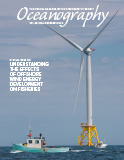Volume 33 | Number 4 | December 2020
Special Issue on Understanding the Effects of Offshore Wind Energy Development on Fisheries
On the Cover: Constructed in 2015–2016, Block Island Wind Farm off the coast of Rhode Island was the first commercial offshore wind farm in the United States. It provided an opportunity to begin to understand the potential effects of such development on coastal resources in the US Atlantic, a focus of several articles in this special issue. Photo credit: Ørsted
Cover PDF

SPECIAL ISSUE FEATURES
FROM THE GUEST EDITORS • Introduction to the Special Issue on Understanding the Effects of Offshore Wind Development on Fisheries
By
Emily Twigg,
Susan Roberts, and
Eileen Hofmann
Offshore Wind Development in the Northeast US Shelf Large Marine Ecosystem: Ecological, Human, and Fishery Management Dimensions
By
Elizabeth T. Methratta,
Anne Hawkins,
Brian R. Hooker,
Andrew Lipsky, and
Jonathan A. Hare
Considerations for Offshore Wind Energy Development Effects on Fish and Fisheries in the United States: A Review of Existing Studies, New Efforts, and Opportunities for Innovation
By
Ruth L. Perry and
William D. Heyman
Offshore Wind Projects and Fisheries: Conflict and Engagement in the United Kingdom and the United States
By
Claire Haggett,
Talya ten Brink,
Aaron Russell,
Michael Roach,
Jeremy Firestone,
Tracey Dalton, and
Bonnie J. McCay
Offshore Wind Farm Artificial Reefs Affect Ecosystem Structure and Functioning: A Synthesis
By
Steven Degraer,
Drew A. Carey,
Joop W.P. Coolen,
Zoë L. Hutchison,
Francis Kerckhof,
Bob Rumes, and
Jan Vanaverbeke
Offshore Wind Energy and Benthic Habitat Changes: Lessons from Block Island Wind Farm
By
Zoë L. Hutchison,
Monique LaFrance Bartley,
Steven Degraer,
Paul English,
Anwar Khan,
Julia Livermore,
Bob Rumes, and
John W. King
Effects of the Block Island Wind Farm on Coastal Resources: Lessons Learned
By
Drew A. Carey,
Dara H. Wilber,
Lorraine B. Read,
Marisa L. Guarinello,
Matthew Griffin, and
Steven Sabo
Acoustic Impacts of Offshore Wind Energy on Fishery Resources: An Evolving Source and Varied Effects Across a Wind Farm’s Lifetime
By
T. Aran Mooney,
Mathias H. Andersson, and
Jenni Stanley
The Interaction Between Resource Species and Electromagnetic Fields Associated with Electricity Production by Offshore Wind Farms
By
Zoë L. Hutchison,
David H. Secor, and
Andrew B. Gill
The Effects of Offshore Wind Farms on Hydrodynamics and Implications for Fishes
By
Joshua van Berkel,
Hans Burchard,
Asbjørn Christensen,
Lars O. Mortensen,
Ole Svenstrup Petersen, and
Frank Thomsen
Setting the Context for Offshore Wind Development Effects on Fish and Fisheries
By
Andrew B. Gill,
Steven Degraer,
Andrew Lipsky,
Ninon Mavraki,
Elizabeth Methratta, and
Robin Brabant
DEPARTMENTS
QUARTERDECK • A Decade of Career Profiles: Recommendations for Job-Hunting
By
Ellen S. Kappel
COMMENTARY • Fostering Global Science Networks in a Post-COVID-19 World
By
Alistair J. Hobday,
Carol Robinson,
Eugene J. Murphy,
Alice Newton,
Marion Glaser, and
Stephanie Brodie
RIPPLE MARKS • Lovely, Dark, and Deep: Forests Behind the Tide
By
Cheryl Lyn Dybas
WORKSHOP REPORT • Leveraging Design Principles to Inform the Next Generation of NASA Earth Satellites
By
Joel P. Scott and
Erin Urquhart
Special Issue Guest Editors
Emily Twigg, The National Academies of Sciences, Engineering, and Medicine
Susan Roberts, The National Academies of Sciences, Engineering, and Medicine
Eileen Hofmann, Old Dominion University
Sponsors
Support for this special issue was provided by the Bureau of Ocean Energy Management’s Office of Renewable Energy Programs and the U.S. Department of Energy’s Wind Energy Technology Office in the Office of Energy Efficiency and Renewable Energy.
Neither the United States Government nor any agency thereof, nor any of their employees, makes any warranty, express or implied, or assumes any legal liability or responsibility for the accuracy, completeness, or usefulness of any information. The views and opinions of authors expressed herein do not necessarily state or reflect those of the United States Government or any agency thereof.
